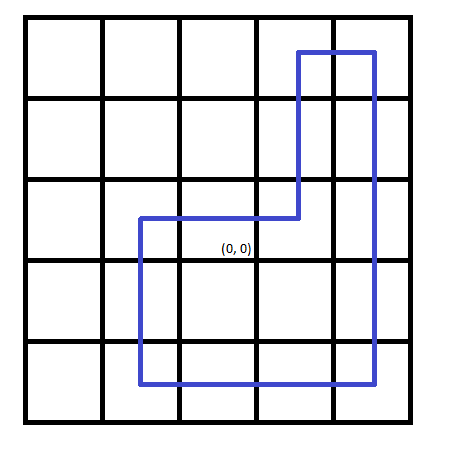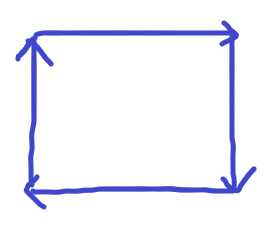标签:ash character infinite html guarantee spl HERE 内存 page
Recently you have bought a snow walking robot and brought it home. Suppose your home is a cell (0,0)
on an infinite grid.
You also have the sequence of instructions of this robot. It is written as the string s
consisting of characters ‘L‘, ‘R‘, ‘U‘ and ‘D‘. If the robot is in the cell (x,y
right now, he can move to one of the adjacent cells (depending on the current instruction).
You‘ve noticed the warning on the last page of the manual: if the robot visits some cell (except (0,0)
) twice then it breaks.
So the sequence of instructions is valid if the robot starts in the cell (0,0)
, performs the given instructions, visits no cell other than (0,0) two or more times and ends the path in the cell (0,0). Also cell (0,0) should be visited at most two times: at the beginning and at the end (if the path is empty then it is visited only once). For example, the following sequences of instructions are considered valid: "UD", "RL", "UUURULLDDDDLDDRRUU", and the following are considered invalid: "U" (the endpoint is not (0,0)) and "UUDD" (the cell (0,1)is visited twice).
The initial sequence of instructions, however, might be not valid. You don‘t want your robot to break so you decided to reprogram it in the following way: you will remove some (possibly, all or none) instructions from the initial sequence of instructions, then rearrange the remaining instructions as you wish and turn on your robot to move.
Your task is to remove as few instructions from the initial sequence as possible and rearrange the remaining ones so that the sequence is valid. Report the valid sequence of the maximum length you can obtain.
Note that you can choose any order of remaining instructions (you don‘t need to minimize the number of swaps or any other similar metric).
You have to answer q
independent test cases.
The first line of the input contains one integer q
) — the number of test cases.
The next q
lines contain test cases. The i-th test case is given as the string s consisting of at least 1 and no more than 105characters ‘L‘, ‘R‘, ‘U‘ and ‘D‘ — the initial sequence of instructions.
It is guaranteed that the sum of |s|
(where |s| is the length of s) does not exceed 105 over all test cases (∑|s|≤105).
For each test case print the answer on it. In the first line print the maximum number of remaining instructions. In the second line print the valid sequence of remaining instructions t
, you are allowed to print an empty line (but you can don‘t print it).
6 LRU DURLDRUDRULRDURDDL LRUDDLRUDRUL LLLLRRRR URDUR LLL
2 LR 14 RUURDDDDLLLUUR 12 ULDDDRRRUULL 2 LR 2 UD 0
There are only two possible answers in the first test case: "LR" and "RL".
The picture corresponding to the second test case:
 Note that the direction of traverse does not matter
Note that the direction of traverse does not matterAnother correct answer to the third test case: "URDDLLLUURDR".
先上学长的代码:
因为是无限大的网格,所以最简单的构造方法是走一个矩形框

注意要特判向任意方向走一步再走回起点的情况,样例中有。
1 #include<bits/stdc++.h> 2 #define fi first 3 #define se second 4 #define lson l,mid,p<<1 5 #define rson mid+1,r,p<<1|1 6 #define pb push_back 7 #define ll long long 8 using namespace std; 9 const int inf=1e9; 10 const int mod=1e9+7; 11 const int maxn=1e5+10; 12 int q; 13 char s[maxn]; 14 int main(){ 15 ios::sync_with_stdio(false); 16 //freopen("in","r",stdin); 17 cin>>q; 18 while(q--){ 19 cin>>s+1; 20 int n=strlen(s+1); 21 int L=0,R=0,U=0,D=0; 22 for(int i=1;i<=n;i++){ 23 if(s[i]==‘L‘) ++L; 24 else if(s[i]==‘R‘) ++R; 25 else if(s[i]==‘U‘) ++U; 26 else ++D; 27 } 28 L=R=min(L,R); 29 U=D=min(U,D); 30 if(L&&U==0){ 31 cout<<2<<endl; 32 cout<<"RL"<<endl; 33 }else if(U&&L==0){ 34 cout<<2<<endl; 35 cout<<"DU"<<endl; 36 }else if(U==0||L==0){ 37 cout<<0<<endl; 38 }else{ 39 cout<<L*2+U*2<<endl; 40 for(int i=1;i<=L;i++){ 41 cout<<‘R‘; 42 } 43 for(int i=1;i<=D;i++){ 44 cout<<‘D‘; 45 } 46 for(int i=1;i<=L;i++){ 47 cout<<‘L‘; 48 } 49 for(int i=1;i<=D;i++){ 50 cout<<‘U‘; 51 } 52 cout<<endl; 53 } 54 } 55 return 0; 56 }
再来我的
1 #include <iostream> 2 #include <cstring> 3 using namespace std; 4 5 void fun(void){ 6 char pose[100005],put[100005]; 7 int nums[4]={0},lth; 8 scanf("%s",&pose); 9 lth = strlen(pose); 10 for(int i = 0;i<lth;i++){ 11 if(pose[i]==‘U‘) 12 nums[0] += 1; 13 else if(pose[i]==‘D‘) 14 nums[1]+=1; 15 else if(pose[i]==‘L‘) 16 nums[2]+=1; 17 else if(pose[i]==‘R‘) 18 nums[3]+=1; 19 } 20 if(nums[0]==0||nums[1]==0) 21 if(nums[2]>0&&nums[3]>0){ 22 printf("2\nLR\n"); 23 return ; 24 } 25 if(nums[2]==0||nums[3]==0) 26 if(nums[1]>0&&nums[0]>0){ 27 printf("2\nUD\n"); 28 return ; 29 } 30 if((nums[0]==nums[1]&&nums[0]==0&&nums[3]!=1&&nums[2]!=1)||(nums[2]==nums[3]&&nums[2]==0&&nums[0]!=1&&nums[1]!=1)){ 31 printf("0\n"); 32 return; 33 } 34 35 int hmin,lmin,idx1,idx2,count=0; 36 if(nums[0]>=nums[1]){ 37 idx1 = 1; 38 lmin = nums[1]; 39 } 40 else{ 41 idx1 = 0; 42 lmin = nums[0]; 43 } 44 if(nums[2]>=nums[3]){ 45 idx2 = 3; 46 hmin = nums[3]; 47 } 48 else{ 49 idx2 = 2; 50 hmin = nums[2]; 51 } 52 int j =0; 53 for(int i = 0;i<lmin;i++){ 54 if(idx1){ 55 put[j]=‘D‘; 56 j++; 57 count+=1; 58 } 59 60 else{ 61 put[j]=‘U‘; 62 j++; 63 count+=1; 64 } 65 66 } 67 for(int i = 0;i<hmin;i++){ 68 if(idx2==3){ 69 put[j]=‘L‘; 70 j++; 71 count+=1; 72 } 73 74 else{ 75 put[j]=‘R‘; 76 j++; 77 count += 1; 78 } 79 80 } 81 for(int i = 0;i<lmin;i++){ 82 if(idx1){ 83 put[j]=‘U‘; 84 j++; 85 count+=1; 86 } 87 88 else{ 89 put[j]=‘D‘; 90 j++; 91 count +=1; 92 } 93 94 } 95 for(int i = 0;i<hmin;i++){ 96 if(idx2==3){ 97 put[j]=‘R‘; 98 j++; 99 count+=1; 100 } 101 102 else{ 103 put[j]=‘L‘; 104 j++; 105 count+=1; 106 } 107 108 } 109 put[j]=‘\0‘; 110 if(strlen(put)>lth){ 111 count -= 1; 112 put[j-1]=‘\0‘; 113 } 114 printf("%d\n%s\n",count,put); 115 return ; 116 } 117 118 int main(){ 119 int n; 120 cin>>n; 121 for(int i = 0;i<n;i++){ 122 fun(); 123 } 124 return 0; 125 }
先从时间吧,时间都是N^2,但学长的循环数量明显少于我的循环数量
内存:我开了两个100005的字符串而学长只有一个
这题不涉及算法,就是模拟与思维
很明显,我们的思路大同小异,但是代码简洁度就是天上与地下。
1.在统计四个字母个数时学长用的是整型变量,而我用的是数组,现在想想确实使用变量会比较好,打的东西少,操作方便,看起来舒服。再来就是循环嵌套,个人习惯性问题,可能我的这种阶梯式写法对于一层执行语句不简洁,但是多条执行语句的话,方便分清结构。
2.特判输出,学长直接循环嵌套,而我则是每种情况列举、输出、然后return,感觉学长的嵌套比较香,因为return可能会造成我现在还没有遇到的BUG,比如我退出多层循环喜欢使用GOTO,但是北理的老师不是这么允许他们的学生使用goto因为goto在面对大型程序时会产生一些bug。(这个也是道听途说,但真实性还是比较高的,希望以后有机会写大型程序的时候试试会有什么BUG)
3.答案输出,其实因为思路大同小异,所以都差不多,但是学长的代码是真的简单,加油吧。标签:ash character infinite html guarantee spl HERE 内存 page
原文地址:https://www.cnblogs.com/baizijianyidi/p/12048347.html